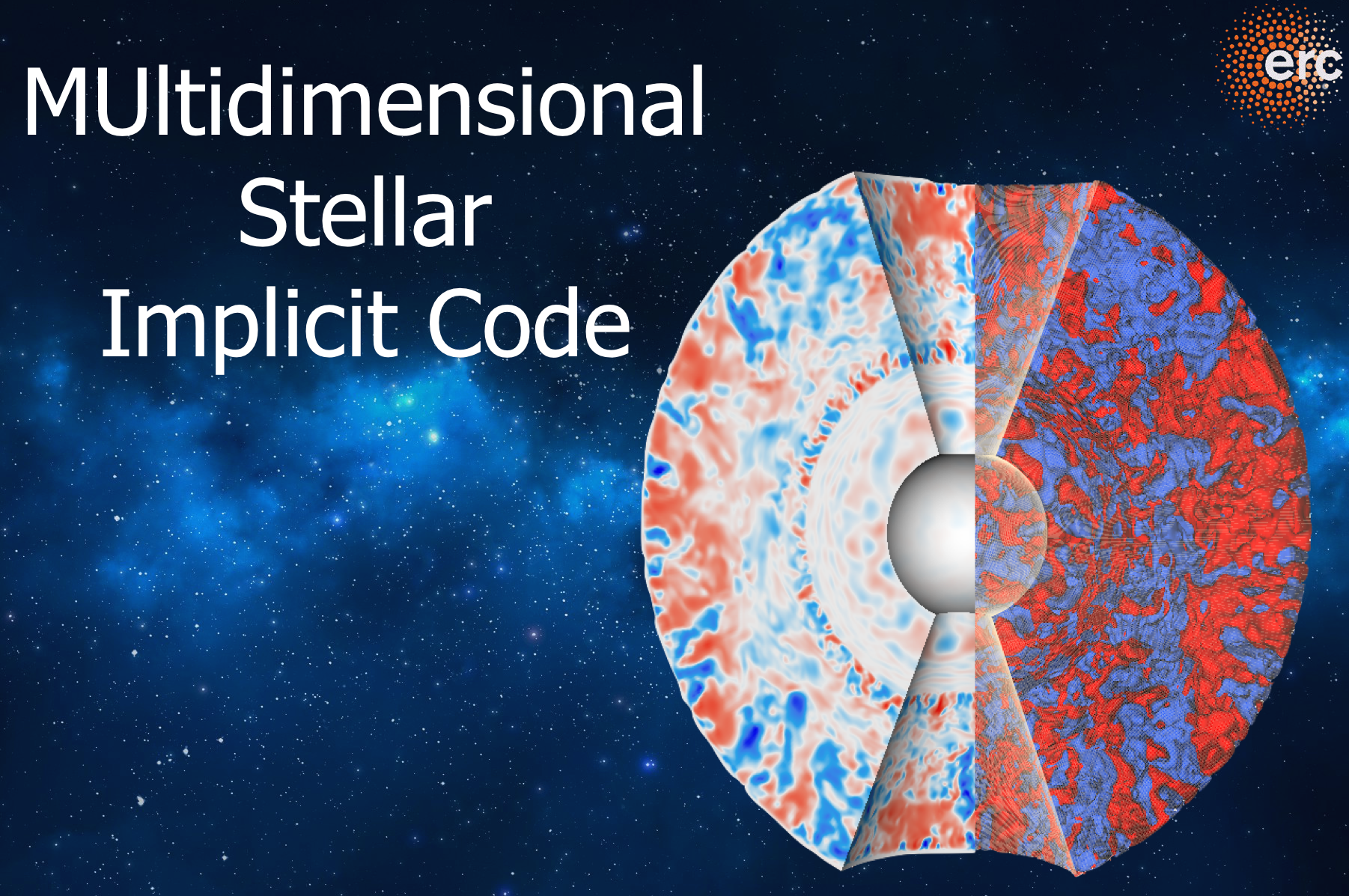

About the MUltidimensional Stellar Implicit Code (MUSIC) |
Current Members of the MUSIC developer's group: |
MUSIC Related PublicationsA. Le Saux, T. Guillet, I. Baraffe, D. Vlaykov, T. Constantino, J. Pratt, T. Goffrey, M. Sylvain, V. Reville, A. S. Brun. "Two-dimensional simulations of solar-like models with artificially enhanced luminosity. II. Impact on internal gravity waves" Astronomy & Astrophysics (submitted Oct 2021). R. Andrassy et al. "Dynamics in a stellar convective layer and at its boundary: Comparison of five 3D hydrodynamics codes" Astronomy & Astrophysics (submitted Oct 2021). I. Baraffe, T. Constantino, J. Clarke, A. Le Saux, T. Goffrey, T. Guillet, J. Pratt, D. G. Vlaykov. "Local heating due to convective overshooting and the solar modelling problem." Astronomy & Astrophysics (accepted Dec 2021). T. Constantino, I. Baraffe, T. Goffrey, J. Pratt, T. Guillet, D. G. Vlaykov, and L. Amard "Suppression of lithium depletion in young low-mass stars from fast rotation" Astronomy & Astrophysics 654 (2021): A146. I. Baraffe, J. Pratt, D. Vlaykov, T. Guillet, T. Goffrey, A. Le Saux, T. Constantino. "Two-dimensional simulations of solar like models with artificially enhanced luminosity - I. impact on convective penetration" Astronomy & Astrophysics 654 (2021): A126. J. Pratt, I. Baraffe, T. Goffrey, T., C. Geroux, T. Constantino, D. Folini, R. Walder. Comparison of 2D and 3D compressible convection in a pre-main sequence star. A&A, 638, A15, 2020. M.V. Popov, R. Walder, D. Folini, T. Goffrey, I. Baraffe, T. Constantino, C. Geroux, J. Pratt, M. Viallet, R. Kaeppeli A well-balanced scheme for the simulation tool-kit A-MaZe: implementation, tests, and first applications to stellar structure. A&A 630, A129, 2019. I. Baraffe, J. Pratt, T. Goffrey, T. Constantino, D. Folini, M.V. Popov, R. Walder, M. Viallet. Lithium depletion in solar-like stars: effect of overshooting based on realistic multi-dimensional simulations. ApJ Lett., 845(1), L6, 2017. J. Pratt, I. Baraffe, T. Goffrey, T. Constantino, M. Viallet, M.V. Popov, R. Walder, and D. Folini. Extreme value statistics for two-dimensional convective penetration in a pre-Main Sequence star. Astronomy and Astrophysics, 604, A125, 2017. T. Goffrey, J. Pratt, M. Viallet, I. Baraffe, M. V. Popov, R. Walder, D. Folini, C. Geroux, T. Constantino. Benchmarking the Multi-dimensional Stellar Implicit Code MUSIC. Astronomy & Astrophysics, 2017. J. Pratt, I. Baraffe, T. Goffrey, C. Geroux, M. Viallet, D. Folini, T. Constantino, M.V. Popov, R. Walder. Spherical-shell boundaries for two-dimensional compressible convection in a star. Astronomy and Astrophysics, 2016. C. Geroux, I. Baraffe, M. Viallet, T. Goffrey, J. Pratt, T. Constantino, R. Walder, D. Folini, and M. V. Popov. Multi-dimensional structure of accreting young stars. Astronomy and Astrophysics, 2016. M. Viallet, T. Goffrey, I. Baraffe, D. Folini, C. Geroux, M. V. Popov, J. Pratt, and R.Walder. A Jacobian-free Newton-Krylov method for time-implicit multidimensional hydrodynamics. Astronomy and Astrophysics, February 2016. J. Pratt, M. Viallet, I. Baraffe, C. Geroux, T. Goffrey, M.V. Popov, D. Folini, R. Walder. "Multi-dimensional models of the interior of stars" (talk and proceedings paper). UK Conference of the Association for Computational Mechanics in Engineering. 2 - 4 April 2014, University of Exeter, Exeter, UK. M. Viallet, I. Baraffe, R. Walder. "Towards a new generation of multi-dimensional stellar evolution models: development of an implicit hydrodynamic codes" arXiv:1103.1524 |
Development of the MUSIC code during the TOFU ProjectThe need to understand and describe stellar interiors and evolutionary properties has been boosted by recent missions devoted to exoplanet searches, like CoRoT and Kepler. Aside from the wealth of new planetary systems, these missions deliver a wealth of asteroseismological data which allows an exploration of stellar properties of unprecedented variety and accuracy. Fundamental aspects of exoplanets require understanding the host star properties. Thus there is a need for a new generation of evolution models for stellar/planetary interiors. A fundamental questions arises: how accurate are presently available stellar models? Are the interior parameters inferred from seismology reliable? Do we understand stellar pulsations? Are heat, chemical species and angular momentum transport in stellar interiors correctly described? To answer these questions, modeling stars and planets in multiple dimensions is a step forward for the field of stellar evolution. The heart of the MUSIC code project is the development of an unique numerical tool, namely a multi-dimensional, time implicit and fully compressible hydrodynamics code, that allows the description of a complete stellar (or planetary) interior over timescales relevant to the study of evolutionary phases. The scientific motivation is to improve the description of key stellar/planetary physical processes and to solve long standing problems characterising the life of stars and planets. The time-implicit approach provides the major innovation in this field as it will allow the exploration of physical processes on spatial and temporal scales presently out of reach. Why do we need multi-dimensional and time implicit numerical simulations to advance in our understanding of stellar and planetary evolution? Current understanding is severely limited, as it essentially relies on one-dimensional calculations to describe highly nonlinear and anisotropic processes in stellar/planetary interiors: turbulence, convection, rotation, instabilities, oscillations, and magnetic fields. Their descriptions are based on phenomenological and qualitative recipes of dubious reliability. Additionally, these processes are characterised by physical timescales much longer than the stellar/planetary hydrodynamical timescale, making presently used multi-dimensional codes in the astrophysical community inappropriate. The MUSIC code project proposes a new vision of stellar/planetary evolution based on a multi-dimensional description of anisotropic and nonlinear processes related to key problems in stellar evolution, like transport of angular momentum, disk accretion, pulsations and turbulent convection. The project will focus on three typical astrophysical examples at the heart of key investigations in stellar formation, evolution and asteroseismology. Beyond these three main astrophysical applications, the project will open new avenues to explore a vast variety of problems in stellar/planetary physics. MUSIC thus delivers a unique numerical tool which lays the foundation of modern stellar and planetary astrophysics. |